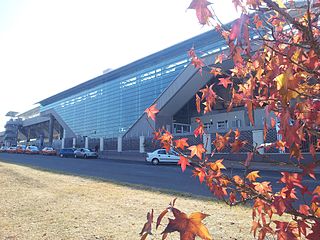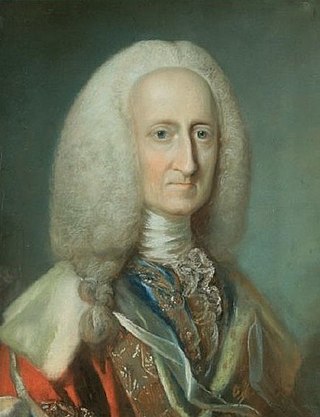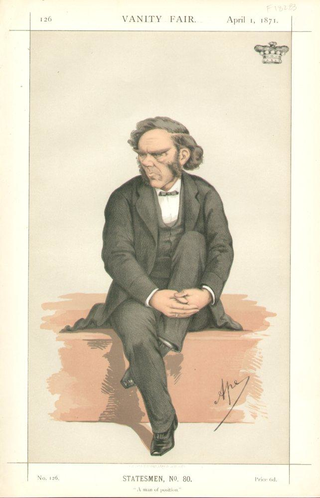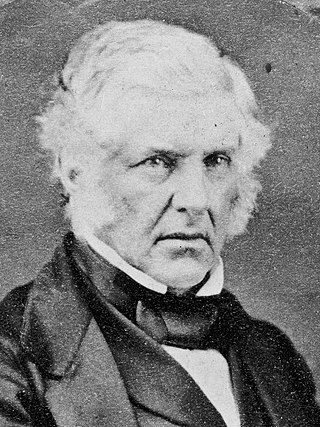
I'm Sorry I Haven't a Clue is a BBC radio comedy panel game. Billed as "the antidote to panel games", it consists of two teams of two comedians being given "silly things to do" by a chairman. The show was launched in April 1972 as a parody of radio and TV panel games, and has been broadcast since on BBC Radio 4 and the BBC World Service, with repeats aired on BBC Radio 4 Extra and, in the 1980s and 1990s, on BBC Radio 2. The 50th series was broadcast in November and December 2007.

Humphrey Richard Adeane Lyttelton, also known as Humph, was an English jazz musician and broadcaster from the Lyttelton family.

Viscount Cobham is a title in the Peerage of Great Britain that was created in 1718. Owing to its special remainder, the title has passed through several families. Since 1889, it has been held by members of the Lyttelton family.

Viscount Chandos, of Aldershot in the County of Southampton, is a title in the Peerage of the United Kingdom and held by a branch of the Lyttelton family. It was created in 1954 for the businessman and public servant Oliver Lyttelton. He was the son of the politician and sportsman Alfred Lyttelton, eighth son of George Lyttelton, 4th Baron Lyttelton, whose eldest son, the 5th Baron Lyttelton, also succeeded his kinsman The 3rd Duke of Buckingham and Chandos as 8th Viscount Cobham in 1889. As of 2017 the title of Viscount Chandos is held by the first Viscount's grandson, the third Viscount, who succeeded his father in 1980. He lost his seat in the House of Lords after the passing of the House of Lords Act of 1999, which removed the automatic right of hereditary peers to sit in the upper chamber of Parliament. However, in 2000 he was given a life peerage as Baron Lyttelton of Aldershot, of Aldershot in the County of Hampshire, and was thus able to return to the House of Lords, where he now sits on the Labour benches. Lord Chandos is also in remainder to the viscountcy of Cobham and its subsidiary titles the barony of Cobham, the barony of Lyttelton, the barony of Westcote and the baronetcy of Frankley.

Centurion is an area with 236,580 inhabitants in the Gauteng Province of South Africa, between Pretoria and Midrand. Formerly an independent municipality, with its own town council, it has been part of the City of Tshwane Metropolitan Municipality since 2000. Its heart is at the intersection of the N1 and N14 freeways. The R21 freeway also passes through the eastern part of Centurion.

Charles John Lyttelton, 10th Viscount Cobham, was the ninth Governor-General of New Zealand and an English cricketer from the Lyttelton family.

Lyttelton is a port town on the north shore of Lyttelton Harbour / Whakaraupō, at the northwestern end of Banks Peninsula and close to Christchurch, on the eastern coast of the South Island of New Zealand.

George Lyttelton, 1st Baron Lyttelton,, known between 1751 and 1756 as Sir George Lyttelton, 5th Baronet, was a British statesman. As an author himself, he was also a supporter of other writers and as a patron of the arts made an important contribution to the development of 18th-century landscape design.

Oliver Lyttelton, 1st Viscount Chandos, was a British businessman from the Lyttelton family who was brought into government during the Second World War, holding a number of ministerial posts.

Alfred Lyttelton KC was a British politician and sportsman from the Lyttelton family who excelled at both football and cricket. During his time at university he participated in Varsity Matches in five sports: cricket (1876–79), football (1876–78), athletics, rackets (1877–79) and real tennis (1877–79), displaying an ability that made him arguably the pre-eminent sportsman of his generation; his only rival in terms of versatility was Oxford's Cuthbert Ottaway. He was, among numerous other achievements, the first man to represent England at both football and cricket. Lyttelton was also a successful politician and served as Secretary of State for the Colonies between 1903 and 1905.

George William Lyttelton, 4th Baron Lyttelton, 4th Baron Westcote, was an English aristocrat and Conservative politician from the Lyttelton family. He was chairman of the Canterbury Association, which encouraged British settlers to move to New Zealand.
Akaroa was a New Zealand electorate. It was located in Banks Peninsula, Canterbury, and named after the town of the same name. One of the original 24 electorates, it existed from 1853 to 1893.

Lyttelton Harbour / Whakaraupō is a major inlet on the northwest side of Banks Peninsula, on the coast of Canterbury, New Zealand; the other major inlet is Akaroa Harbour, which enters from the southern side of the peninsula. Whakaraupō enters from the northern coast of the peninsula, heading in a predominantly westerly direction for approximately 15 km (9.3 mi) from its mouth to the aptly-named Head of the Bay near Teddington. The harbour sits in an eroded caldera of the ancient Banks Peninsula Volcano, the steep sides of which form the Port Hills on its northern shore.

Lyttelton Line is a name sometimes used to refer to the section of the Main South Line in New Zealand's South Island between Lyttelton and Christchurch, and can also be used to refer to the operations on this section. As it has always been part of the Main South Line, this name has never been officially used to refer to the track itself.
Lyttelton is a former New Zealand parliamentary electorate. It existed from 1853 to 1890, and again from 1893 to 1996, when it was replaced by the Banks Peninsula electorate.
Christchurch Country was a parliamentary electorate in the Canterbury region of New Zealand from 1853 to 1860. It was thus one of the original 24 electorates used for the 1st New Zealand Parliament.

The Lyttelton Times was the first newspaper in Canterbury, New Zealand, publishing the first edition in January 1851. It was established by the Canterbury Association as part of its planned settlement of Canterbury and developed into a liberal, at the time sometimes seen as radical, newspaper. A successor paper, The Star, is published as a free bi-weekly newspaper.

The Town of Christchurch by-election in 1860 was triggered by the resignation of Richard Packer as the Member of the House of Representatives for the Town of Christchurch electorate, and occurred during the term of the 2nd New Zealand Parliament. The previous representative of the electorate, the politician Henry Sewell, had returned after three years in England and the general expectation was that Sewell would be the sole contender for election. The Lyttelton Times wrote several provocative editorials, generally endorsing Sewell for his obvious ability, but criticising him for not publicly talking about his policies and plans. Sewell eventually arranged a public meeting the evening prior to nomination day; this was the only public meeting during the election campaign. After a lengthy address, which was favourably received by the Lyttelton Times, a second contender for the office put his name forward at that meeting: the publican Michael Hart. Sewell, a former premier and one of New Zealand's most senior politicians at the time, was successful against the political novice Hart.

St Saviour's at Holy Trinity is an Anglican church in Lyttelton, Christchurch, New Zealand. St Saviour's Chapel was relocated from West Lyttelton to Christchurch's Cathedral Grammar School in the 1970s. Following the earthquakes and the demolition of Holy Trinity Church, Lyttelton, St Saviour's was returned to Lyttelton to the site of Holy Trinity in 2013.

The Lyttelton Borough Council Chambers was the headoffice of the Lyttelton Borough Council from 1887 until the late 20th century, when the borough council moved to a number of other buildings. Civic use of the building stopped in 1999, when the building was sold for business and residential use. Registered by the New Zealand Historic Places Trust in 2003, the building was demolished in June 2011 following the 2011 Christchurch earthquake.




















